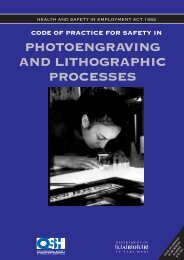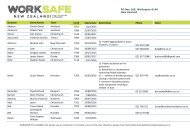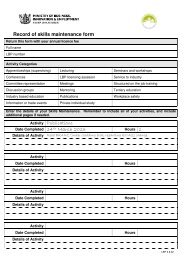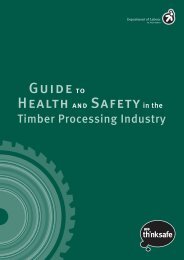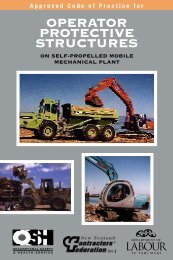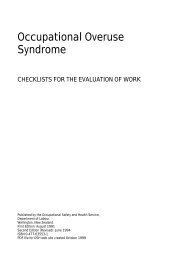First aid for workplaces - a good practice guide - New Zealand Red ...
First aid for workplaces - a good practice guide - New Zealand Red ...
First aid for workplaces - a good practice guide - New Zealand Red ...
Create successful ePaper yourself
Turn your PDF publications into a flip-book with our unique Google optimized e-Paper software.
<strong>First</strong> Aid <strong>for</strong> Workplaces – a Good Practice GuideTable of contentsINTRODUCTION........................................................................................4WHAT FIRST AID IS NEEDED IN WORKPLACES?.......................................5How do I do a Workplace <strong>First</strong> Aid Needs Assessment? ................................. 5HOW MANY TRAINED FIRST AIDERS DO I NEED? .....................................9WORKPLACE FIRST AID NEEDS ASSESSMENT CHECKLIST ...................... 10WHAT FIRST AID EQUIPMENT IS NEEDED? ............................................ 13Do I need a first <strong>aid</strong> kit?.......................................................................... 13What should be in my first <strong>aid</strong> kit? ........................................................... 13Suggested minimum contents <strong>for</strong> a workplace first <strong>aid</strong> kit ........................... 15What signs should I use to identify first <strong>aid</strong> kits? ........................................ 16How many kits do I need and where should they be located?....................... 16What personal protective clothing or equipment might I need? .................... 16What other equipment might some employers need? .................................. 16How should I get rid of waste material? .................................................... 17What in<strong>for</strong>mation should be provided with first <strong>aid</strong> kits?.............................. 17Do I need a first <strong>aid</strong> room?...................................................................... 18HOW DO I RECORD AND REPORT ACCIDENTS?....................................... 18HOW SHOULD I INFORM EMPLOYEES ABOUT FIRST AID HELP THAT’SAVAILABLE? ........................................................................................... 18WHAT TRAINING DO FIRST AIDERS NEED? ............................................ 19HOW CAN FIRST AID FIT TOGETHER WITH HAZARD MANAGEMENT IN MYWORKPLACE? ......................................................................................... 20Hazard and <strong>First</strong> Aid Assessment Register ................................................. 23APPENDIX 1: VEHICLE OR LONE WORKER FIRST AID KIT - SUGGESTEDMINIMUM CONTENTS ............................................................................. 24APPENDIX 2: ADDITIONAL TRAINING FOR FIRST AIDERS ..................... 25APPENDIX 3: FIRST AID REGISTER ........................................................ 26APPENDIX 4: HOW SHOULD A FIRST AID ROOM BE SET UP? .................. 27APPENDIX 5: WHAT DOES THE LAW SAY ABOUT THE NEED FOR FIRST AIDIN WORKPLACES? .................................................................................. 28DEFINITIONS ......................................................................................... 293
<strong>First</strong> Aid <strong>for</strong> Workplaces – a Good Practice Guide?Think about: specific hazards such as potentially hazardous substances,tools, machinery or activitiesHow many employees and other people are in the workplace and whereare they located?The number of people you employ will affect the facilities you need, whether youneed trained first <strong>aid</strong>ers, and if so, how many first <strong>aid</strong>ers you need.When thinking about how many trained first <strong>aid</strong>ers you need, take into accountthings like:• the number of employees at work at any given time• the sort of work they do, and the sorts of hazards they face• the likelihood of people being hurt, and how serious the injuries might be• the size of your workplace and whether people are working in scatteredlocations within the site• the location of your workplace, and the distance from medical services• whether people other than employees are presentAllow <strong>for</strong> some of your first <strong>aid</strong>ers to be absent on planned or unplanned leave,such as sick leave.Your first <strong>aid</strong> provisions must cover all hours when employees are working,including shifts and overtime. Employees working outside normal working hoursneed access to first <strong>aid</strong>.If you employ people with disabilities or special needs, think about their medicaland first <strong>aid</strong> needs. This is best done in consultation with the employeesconcerned, and with the consent of the workers, upon medical advice.?Think about: Seasonal workers, temporary workers, part time workers,shift workersIf employees of more than one employer are working together can theyshare first <strong>aid</strong> resources?If people employed by different employers are working together and want toavoid duplication, they can arrange to share first <strong>aid</strong> provisions. For example, theemployers might agree that first <strong>aid</strong> provisions will be made by the employer withthe largest number of employees on site.The agreement should be in writing and a copy kept by each employer involved.Each employer must make sure their employees understand the first <strong>aid</strong>arrangements.6
<strong>First</strong> Aid <strong>for</strong> Workplaces – a Good Practice GuideHOW MANY TRAINED FIRST AIDERS DO I NEED?How many trained first <strong>aid</strong>ers you need will depend on the hazards in yourworkplace, the number and location of your employees and how close you are tomedical services. Completing the Needs Assessment will give you an idea of howmany trained first <strong>aid</strong>ers are needed at your workplace.Here are some examples to help you think about what might be needed in yourworkplace.• Alex runs a small IT company that employs three people and is based inthe city close to a medical centre. His low hazard workplace has notrained first <strong>aid</strong>ers.• Mark has a small residential company employing five people. He has twotrained first <strong>aid</strong>ers.• Lesley’s farm is in a rural area with limited access to medical andambulance services. She has two first <strong>aid</strong>ers <strong>for</strong> every 10 employees.• Flo manages a large telephone contact centre in a suburban area. Herlow risk workplace always has two first <strong>aid</strong>ers present <strong>for</strong> every 50employees at work.• David’s roading company deals with significant hazards, includingmachinery, traffic hazards, and chemicals. He always has at least twofirst <strong>aid</strong>ers present <strong>for</strong> up to 25 employees.?Think about:• ensuring that first <strong>aid</strong> cover is provided on all shifts• rosters and managing planned/unplanned absences to ensure thata first <strong>aid</strong>er is available during working hours• determining if the level of first <strong>aid</strong> response is appropriate to thehazards faced by workers9
<strong>First</strong> Aid <strong>for</strong> Workplaces – a Good Practice GuideWORKPLACE FIRST AID NEEDS ASSESSMENT CHECKLISTThis checklist will help you work out what first <strong>aid</strong> is needed in your workplaceIssue Suggested Impact on <strong>First</strong> Aid Provision ActionWhat likelihood is there of injury and ill health arisingfrom work?Are there any job or task-specific significant hazards,e.g.:• Hazardous substances• Hazardous tools• Hazardous machinery• Hazardous loads• Hazardous animals• Working at height• Large industrial sites• Commercial diving• Adventure tourismAre there parts of the workplace where differentsignificant hazards can be identified, e.g. an officecompared with a processing factory?Are large numbers of people employed?Are there employees with reading, hearing or languagedifficulties?Higher likelihood: train more first <strong>aid</strong>ers and expand first<strong>aid</strong> stock.Consider:• Specific or advanced training <strong>for</strong> first <strong>aid</strong>ers• Extra first <strong>aid</strong> equipment• Precise locations of first <strong>aid</strong> equipment• Making prior arrangements with emergencyservices• A first <strong>aid</strong> roomAlternative levels of first <strong>aid</strong> provision <strong>for</strong> different parts ofthe organisation.Extra first <strong>aid</strong>ers, more equipment and possibly a first <strong>aid</strong>room to cope with the higher likelihood of an accidentoccurring.Provide specialised training to ensure that they know howto access first <strong>aid</strong> provisions when required.10
<strong>First</strong> Aid <strong>for</strong> Workplaces – a Good Practice GuideOther issues at your workplace Suggested Impact on <strong>First</strong> Aid Provision Action12
<strong>First</strong> Aid <strong>for</strong> Workplaces – a Good Practice GuideWHAT FIRST AID EQUIPMENT IS NEEDED?Completing the Workplace <strong>First</strong> Aid Needs Assessment checklist will help youidentify what equipment and how many first <strong>aid</strong>ers you need. This sectionprovides more detailed in<strong>for</strong>mation on things like what should be in your first <strong>aid</strong>kits and where to locate them.Do I need a first <strong>aid</strong> kit?There should be a suitably stocked first <strong>aid</strong> kit in each place where people areworking. There should also be a kit in work vehicles.Figure 1: standard first <strong>aid</strong> sign<strong>First</strong> <strong>aid</strong> kits must be made of sturdy material and bedesigned to protect the contents from damp, dust andcontamination. Kits must be clearly identified as first <strong>aid</strong>containers. The marking must be a white cross on a greenbackground.The kits can be of any size, but they must be large enough to fit the contents,and be of a sufficient size to cope with the number of people needing to use it.The size of the kit will depend on whether or not it is designed to operate as amobile, lone worker, vehicle or commercial premises kit.What should be in my first <strong>aid</strong> kit?Below is a list of suggested minimum contents <strong>for</strong> first <strong>aid</strong> kits in <strong>workplaces</strong> withno special risks.However, the content of your first <strong>aid</strong> kit must take account of the circumstancesand hazards of your workplace. So the contents should be decided based on theoutcome of your Needs Assessment. Where particular hazards exist, the kitsshould be provided with additional contents.Appendix 1 has a list of suggested minimum contents <strong>for</strong> mobile first <strong>aid</strong> kits.They can be given to people working away from the usual workplace or <strong>for</strong> workvehicles. Where particular hazards exist, mobile kits should be provided withadditional contents.<strong>First</strong> <strong>aid</strong> kits must be checked regularly. Ensure they are replenished as soon aspossible after use, so there’s always an adequate supply of equipment available.Items should be replaced be<strong>for</strong>e the expiry date shown on the packaging, whereapplicable.Nothing other than first <strong>aid</strong> equipment or related equipment, such as pens andaccident report <strong>for</strong>ms, should be in the kits.13
<strong>First</strong> Aid <strong>for</strong> Workplaces – a Good Practice GuideWhat signs should I use to identify first <strong>aid</strong> kits?It’s recommended that you use first <strong>aid</strong> signs that clearly show the locations offirst <strong>aid</strong> equipment. This makes the equipment easier to locate in an emergency.Signs should comply with NZS/AS 1319: 1994 Safety Signs <strong>for</strong> the OccupationalEnvironment or an equivalent applicable standard. See the Standards NZ website<strong>for</strong> in<strong>for</strong>mation on standards www.standards.co.nzHow many kits do I need and where should they be located?You need at least one full basic first <strong>aid</strong> kit in each place where people areworking, which includes work vehicles. Additional kits may be required dependingon the outcome of your needs assessment.There should be at least one kit on each floor of a multi-level workplace. If youhave more than 50 employees, it’s recommended that an additional kit should beprovided, and <strong>for</strong> every additional 50 employees another kit should be provided.<strong>First</strong> <strong>aid</strong> kits should be located so they’re clearly visible and accessible to allemployees, and should be unlocked wherever possible. Sealed emergency kitsshould be available where kits must be locked.<strong>First</strong> <strong>aid</strong> kits should be located close to a wash basin with hot and cold runningwater and clean towels. If because of the location clean running water isn’tavailable, sterile saline solution or wipes should be supplied in the kits, and handsanitising gel should also be available.Kits should be located close to areas of particular or special hazards.Wall-mounted kits should be removable, and be of a size and weight that oneperson can carry.What personal protective clothing or equipment might Ineed?Disposable gloves should be provided <strong>for</strong> use by people giving first <strong>aid</strong>, to reducethe risk of them transmitting disease and infections from person to person.If your Needs Assessment suggests other protective clothing and equipment isneeded - such as non-absorbent aprons, face visors and non-absorbent overalls -this should be stocked near the first <strong>aid</strong> kit. The equipment should be checkedregularly to ensure it is in <strong>good</strong> condition.<strong>First</strong> <strong>aid</strong>ers must be trained so they can safely use personal protective clothingand equipment.What other equipment might some employers need?If your workplace has particular hazards like chemicals you may need additionalfirst <strong>aid</strong> provisions. This might include things like:• immediate access to safety data sheets <strong>for</strong> dealing with chemicals16
<strong>First</strong> Aid <strong>for</strong> Workplaces – a Good Practice Guide• personal protective clothing or equipment <strong>for</strong> the first <strong>aid</strong>ers if they needto enter a hazardous area• ice or instant cold packs• biohazard bags.If a workplace covers a large area, or is divided into a number of separate selfcontainedworking areas, consider providing suitable carrying equipment totransport casualties.If blankets are provided, they should be stored alongside the first <strong>aid</strong> equipment,and kept free from dust and damp.Other first <strong>aid</strong> equipment, including AEDs (defibrillators), oxygen and medicinesmay be supplied on specialist advice. People must not operate equipment thatrequires specialist training unless they have that training.If respirators with cartridges are part of your emergency first <strong>aid</strong> equipment, theymust be regularly maintained and the cartridges replaced as the manufacturerrecommends.How should I get rid of waste material?Plastic disposable bags that can be sealed closed should be provided <strong>for</strong> soiledfirst <strong>aid</strong> dressings, disposable equipment and gloves. Ensure that used dressingsand other biologically contaminated equipment are safely disposed of in order toreduce the risk of cross-infection.If needles or other sharp instruments require disposal, a sharps disposal bin anda contract <strong>for</strong> its safe removal is recommended.What in<strong>for</strong>mation should be provided with first <strong>aid</strong> kits?Each first <strong>aid</strong> kit should contain the names, job titles and contact details <strong>for</strong> thefirst <strong>aid</strong>ers. They should also contain emergency contact numbers (ambulance,hospital, and doctor, etc).The Department of Labour and the Environmental Risk Management Authority<strong>New</strong> <strong>Zealand</strong> have developed an Emergency Response Flip Chart, where thecontact details <strong>for</strong> first <strong>aid</strong>ers can be listed. The Flip Chart contains basicemergency in<strong>for</strong>mation <strong>for</strong> fire, chemical spills, accidents and natural disasters.This can be downloaded from:http://www.ermanz.govt.nz/resources/publications/pdfs/ERMA%20Flip%20Chart.pdfIt’s recommended that writing materials are kept in or near the kit so people canrecord what has been used. This will help you make sure the kit is restocked in atimely way.The Department of Labour has a <strong>for</strong>m that can be used to record these details.This “The <strong>First</strong> Aid Register” <strong>for</strong>m can be downloaded from17
<strong>First</strong> Aid <strong>for</strong> Workplaces – a Good Practice Guidehttp://www.osh.dol.govt.nz/order/catalogue/<strong>for</strong>ms.shtml. There’s a copy of the<strong>for</strong>m in Appendix 3.Do I need a first <strong>aid</strong> room?Employers in large <strong>workplaces</strong>, <strong>for</strong> example those with more than 100 employees,should consider providing a first <strong>aid</strong> room to cope with the higher likelihood of anaccident occurring.Employers should also consider the need <strong>for</strong> a first <strong>aid</strong> room if their workplace islocated somewhere where access to medical facilities is difficult, or where thereare significant hazards in the workplace.More in<strong>for</strong>mation on how to set up a first <strong>aid</strong> room is in Appendix 4.HOW DO I RECORD AND REPORT ACCIDENTS?By law, employers, the self-employed and principals (people who hirecontractors) must keep a register of all accidents and near misses, and allincidents when someone is seriously harmed at work.The register must be kept in a certain way, and the Department of Labour has a<strong>for</strong>m you can download – called the Form of Register or Notification ofCircumstances of Accident or Serious Harm - that meets these requirements.Copies of the <strong>for</strong>m should be kept in or near the first <strong>aid</strong> kit. It can bedownloaded from http://www.osh.dol.govt.nz/order/catalogue/<strong>for</strong>ms.shtml.If someone is seriously harmed at work, the employer, self-employed person orprincipal (someone who hires contractors) must notify the Department of Labouras soon as possible. They must also send a completed copy of the Form ofRegister or Notification of Circumstances of Accident or Serious Harm to theDepartment within 7 days after the accident, or as soon as possible after theyfind out about it. For more in<strong>for</strong>mation on reporting accidents go to:http://www.osh.dol.govt.nz/services/notification/accident.shtml.HOW SHOULD I INFORM EMPLOYEES ABOUT FIRST AIDHELP THAT’S AVAILABLE?All employees must be given clear in<strong>for</strong>mation about first <strong>aid</strong> available in theworkplace, including the location of first <strong>aid</strong> kits, the names and locations of first<strong>aid</strong>ers, the location of any first <strong>aid</strong> room and procedures to follow when first <strong>aid</strong> isneeded. This in<strong>for</strong>mation should be given:• when an employee is first employed• when there is a change in the nature or location of the duties theemployee per<strong>for</strong>ms• when there’s a significant change in personnel – <strong>for</strong> example if the first<strong>aid</strong>ers are replaced• at regular intervals to refresh and remind them – <strong>for</strong> example annually.18
<strong>First</strong> Aid <strong>for</strong> Workplaces – a Good Practice GuideEmployees have useful in<strong>for</strong>mation about the hazards people face at work andcircumstances that can affect access to first <strong>aid</strong>. So it’s recommended that youinvolve them in the planning and provision of first <strong>aid</strong> at work. Giving employeesreasonable opportunities to participate effectively in processes to improve healthand safety is also a requirement of the HSE Act.WHAT TRAINING DO FIRST AIDERS NEED?It is recommended that training of workplace first <strong>aid</strong>ers is carried out by peoplewho work <strong>for</strong> an organisation accredited by the <strong>New</strong> <strong>Zealand</strong> QualificationsAuthority. A list of registered training providers is available atwww.nzqa.govt.nz/providers/index.do<strong>First</strong> <strong>aid</strong> certificates are issued by training providers and are evidence that theperson has completed the requirements <strong>for</strong> the certificate. They are valid <strong>for</strong> twoyears.A refresher course is recommended every two years to keep the first <strong>aid</strong>certificate current, and update the first <strong>aid</strong>er’s knowledge.If a certificate has lapsed <strong>for</strong> more than three calendar months from thecertificate’s expiry date, the certificate holder should complete a full first <strong>aid</strong>course.Training courses can be conducted at, or away from, your workplace.For further in<strong>for</strong>mation on first <strong>aid</strong> training requirements, visit the NZQA websitewww.nzqa.govt.nz.19
<strong>First</strong> Aid <strong>for</strong> Workplaces – a Good Practice GuideHOW CAN FIRST AID FIT TOGETHER WITH HAZARDMANAGEMENT IN MY WORKPLACE?The HSE Act includes a practical process that helps employers and others keeptheir <strong>workplaces</strong> safe. The process has three steps:- identify hazards in your workplace- consider if they are significant hazards that could cause serious harm- take steps to protect people from hazards by – in order of preference –eliminating, isolating or minimising exposure to the hazards.The Hazard and <strong>First</strong> Aid Assessment Register below shows you how you can useyour hazard management process to help identify your first <strong>aid</strong> requirements, andcombine the two in one easy to read worksheet.Below is a short reminder of what you need to do to manage hazards.1Identify the hazards in your workplaceYou can do this by conducting a site assessment of your workplace and notingany physical, chemical, environmental, biological, or other hazards that couldpotentially harm employees and others in the workplace. Note, work processes orchanges in processes can cause hazards.Involve employees in this process. Employees can have valuable in<strong>for</strong>mationabout the hazards they face and how to manage them, and involving them inimproving health and safety is also a requirement of the HSE Act.2Consider the significance of the hazards – are they likely to causeserious harm?The next step is to work out if each hazard could cause serious harm and isthere<strong>for</strong>e significant.Serious harm includes death and things like bone fractures, lacerations, crushing,amputation, burns requiring specialist treatment etc. It includes occupationalillnesses as well as physical injuries. A full definition can be found athttp://www.osh.govt.nz/law/quick<strong>guide</strong>/glossary.shtml#_serSerious harm also includes harm that has the potential to become more seriousthe more often people are exposed to the hazard. And it includes harm that maynot be easily detectable until some time after the person has been exposed to thehazard.20
<strong>First</strong> Aid <strong>for</strong> Workplaces – a Good Practice GuideHelpful questions to help you work out if a hazard is significant and could seriousharm include:• How often are employees exposed to the hazard?• When employees are exposed, how long are they exposed <strong>for</strong>?• Are the possible injuries or illnesses likely to be sudden and severe, ordevelop slowly and last a long time?3Eliminate, isolate or minimise the hazards as far as practicable toreduce employee exposure to potential sources of harmEmployers are required to manage significant hazards to reduce the likelihood ofemployees being harmed. They must take all practicable steps to eliminate,isolate or minimise the hazards.Eliminate: this is the preferred option. It means removing the hazard altogetherso it can’t harm anyone.Isolate: this is the next preferred option. It means enclosing the hazard so itcan’t be reached by anyone. One example is machine guarding.Minimise: this is the least preferred option. It means minimising the likelihood ofpeople being harmed by providing things like training, personal protectiveclothing or equipment, signs, and by ensuring that emergency procedures are inplace to cope with accidents.Simply providing first <strong>aid</strong> will not cover your legal obligation to manage significanthazards. But it will help meet your obligation to provide an appropriateemergency response procedure in the event of an accident.The Hazard and <strong>First</strong> Aid Assessment Register over shows how you can expandyour hazard management plans to include first <strong>aid</strong> provisions. This will give you auseful snapshot of how health and safety can be managed in your workplace.21
<strong>First</strong> Aid <strong>for</strong> Workplaces – a Good Practice GuideExample of a Hazard and <strong>First</strong> Aid Assessment RegisterLocation Date of AssessmentHazard Injury or Illness Significance Eliminate, Isolate orControls<strong>First</strong> Aid RequirementsMinimiseManual handling Sprains, strains, fractures Can range fromlesser harm toMinimise Lifting equipment, team lifts, trainingon safe manual handlingIce packs, bandages,splintssignificant harmFallsFractures, bruises, cuts,dislocations, concussionLikely to causesignificant harmIsolate, Minimise Scaffolding, use harnesses, <strong>for</strong>kliftcages, handrails, suitable footwear,slip/trip/fall hazard IDIce packs, bandages,wound dressings, CPR,splintsElectricityShock, burns, loss ofconsciousness, cardiacLikely to causesignificant harmMinimise Inspect and tag electrical leads,work to be conducted by registeredIce packs, bandages,wound dressings, CPRarrestelectriciansPlant/machinery Cuts, bruises, dislocations,dermatitis, fractures,amputation, eye damageLikely to causesignificant harmIsolate, Minimise Machine guarding, training in safeoperating and maintenanceprocedures, personal protectiveIce packs, bandages,wound dressings, eyepads, tweezers, <strong>for</strong>cepsclothingHazardoussubstancesDizziness, vomiting,respiratory problems, burnsto skin or eyesLikely to causesignificant harmEliminate, Isolate,MinimiseSubstitute with less hazardoussubstances, isolate processes,training in safe work processes,personal protective clothingEmergency shower, eyewash facilities, safety datasheets, eye pads, wounddressings, gloves, aprons,oxygenTemperature, UVradiationSunburn, frostbite, heatstress, heat stroke,hypothermiaCan range fromlesser harm tosignificant harmMinimise <strong>Red</strong>uce employee exposure totemperature extremes wherepracticable, sunscreen, appropriateclothing, provide shadeWater or electrolyterehydration fluids,thermal blankets, icepacksOccupationalviolenceNausea, shock, collapse,physical injuriesLikely to causesignificant harmMinimise CCTV, staff training, security Water, blankets, CPR,wound dressings,bandages, etc22
<strong>First</strong> Aid <strong>for</strong> Workplaces – a Good Practice GuideHazard and <strong>First</strong> Aid Assessment RegisterLocation Date of AssessmentHazard Injury or Illness Significance Eliminate, Isolateor MinimiseControls<strong>First</strong> AidRequirements23
<strong>First</strong> Aid <strong>for</strong> Workplaces – a Good Practice GuideAPPENDIX 1: VEHICLE OR LONE WORKER FIRST AID KIT- SUGGESTED MINIMUM CONTENTSThis appendix lists the recommended contents <strong>for</strong> a vehicle or lone worker’s first<strong>aid</strong> kit:• a leaflet giving general guidance on first <strong>aid</strong>• six individually wrapped sterile adhesive dressings (assorted sizes),appropriate to the type of work• two individually wrapped triangular bandages (sterile)• one stretch bandage• clasps or safety pins to tie bandages• one large sterile individually wrapped unmedicated wound dressing –approximately 18cm x 18cm• one pair of disposable gloves• one resuscitation mask.This is a suggested contents list only; equivalent but different items will beconsidered acceptable. This kit can be carried in individual belt pouches by peopleworking alone.Once the employer has completed their assessment of the first <strong>aid</strong> itemsrequired, a need <strong>for</strong> additional items may be identified. This could include, <strong>for</strong>example:• scissors• adhesive strips or band-<strong>aid</strong>s <strong>for</strong> minor wound dressing• non-allergenic adhesive tape• disposable aprons• <strong>for</strong>ceps or tweezers to remove <strong>for</strong>eign bodies• plastic bags <strong>for</strong> waste disposal• individually wrapped moist wipes or saline solution• plastic bags <strong>for</strong> waste disposal.The contents of vehicle or lone worker first <strong>aid</strong> kits should be stocked frombackup stock at the main work site.Consideration also needs to be given as to how mobile and lone workers cansummon help if they are injured. Examples are the provision of mobile phones,radio access, GPS or a phone check-in procedure.24
<strong>First</strong> Aid <strong>for</strong> Workplaces – a Good Practice GuideAPPENDIX 2: ADDITIONAL TRAINING FOR FIRSTAIDERSSpecialist training is additional to the basic first <strong>aid</strong> training, and can apply to<strong>workplaces</strong> where the employer identifies the needs <strong>for</strong> additional skills. Thetraining should be designed to meet the following learning outcomes relative to aspecific hazard.At the end of the additional training, first <strong>aid</strong>ers will be able to:• describe the nature of the hazard and the methods to manage it• describe the signs, symptoms and treatment of conditions produced byexposure to the hazard• describe the actions of antidotes (if any), the procedure <strong>for</strong> administeringantidotes, and any risks associated with administration to casualties;• demonstrate the use of appropriate specialist equipment and methods ofapplying first <strong>aid</strong> treatment• demonstrate the maintenance of detailed records of incidents whereadditional methods of first <strong>aid</strong> treatment are used.25
<strong>First</strong> Aid <strong>for</strong> Workplaces – a Good Practice GuideAPPENDIX 3: FIRST AID REGISTERThis <strong>for</strong>m can be used to record details of situations where first <strong>aid</strong> treatment isadministered.Employee’s NameDepartment/WorkAreaDate of TreatmentTime of Treatment<strong>First</strong> AiderDescription of InjuryTreatment Provided<strong>First</strong> <strong>aid</strong> items usedReminder: replenish the first <strong>aid</strong> kit with disposed of items.If a work-related accident has occurred, please complete your organisation’sAccident Report Form or the Department of Labour’s Form of Register orNotification of Circumstances of Accident or Serious Harm.26
<strong>First</strong> Aid <strong>for</strong> Workplaces – a Good Practice GuideAPPENDIX 4: HOW SHOULD A FIRST AID ROOM BE SETUP?If you provide a first <strong>aid</strong> room ensure that:• someone is available to take responsibility <strong>for</strong> the room and its contents,including ensuring that it’s cleaned regularly and that stocks arereplenished• the room is always readily available when employees are at work,including during shift work and overtime• preferably the room shouldn’t be used <strong>for</strong> any other purpose, althoughyou may want to consider using it <strong>for</strong> employees who are breastfeedingmothers• the room is located on a ground floor, as near as possible to a buildingentrance and is signposted so emergency services can easily find it. Yourlocal ambulance service may be able to provide advice on the bestaccess points• the room has ventilation and heating and is well lit• the room is large enough to hold a couch or bed with space <strong>for</strong> people towalk around it, and a chair• the entrance to the room is wide enough to accommodate a stretcher,wheelchair or carrying chair• the room contains suitable first <strong>aid</strong> facilities and equipment, has awaterproof floor covering and is well maintained. All surfaces should beeasy to clean and should be cleaned regularly. There should be suitablearrangements <strong>for</strong> disposing of rubbish, and laundering sheets, blanketsand towels, where needed• The room has a basin with hot and cold running water, soap and cleandisposable towels• The room has cupboards <strong>for</strong> storing first <strong>aid</strong> supplies.27
<strong>First</strong> Aid <strong>for</strong> Workplaces – a Good Practice GuideAPPENDIX 5: WHAT DOES THE LAW SAY ABOUT THENEED FOR FIRST AID IN WORKPLACES?Under the Health and Safety in Employment Regulations 1995 employers arerequired to take all practicable steps to ensure:• first <strong>aid</strong> facilities are provided at every place of work under the control ofthe employer• the facilities are suitable <strong>for</strong> the purpose <strong>for</strong> which they are used• the facilities are provided in sufficient numbers• the facilities are maintained in <strong>good</strong> order and condition• all employees have access to these facilities in a way that is convenientto them.The relevant regulations are:• regulation 4(2)(d), to be read in conjunction with regulation 7.The Health and Safety in Employment Act 1992 doesn’t contain any specificprovisions requiring first <strong>aid</strong> facilities. But it imposes a duty on employers to takeall practicable steps to ensure the safety of employers and others in the place ofwork. In some circumstances this may be achieved by the provision of first <strong>aid</strong>equipment, facilities, training and in<strong>for</strong>mation.The relevant sections of the Act are:• section 6(a), (b) and (e)• section 12(1)(a) to (d)• section 16(2)(b)• section 18.Employers are also required by section 19B of the HSE Act to involve employeesin health and safety matters, including matters referred to in sections 6 to 13 ofthe Act.To view the full legislation, visit www.legislation.govt.nz28
<strong>First</strong> Aid <strong>for</strong> Workplaces – a Good Practice GuideDEFINITIONSFor the purposes of this Guide, the following definitions apply.AED:means Automated External Defibrillator. A defibrillator applies ashort powerful electric shock to the heart, allowing the heart toregain its natural rhythm.All practicablesteps:has the same meaning as the definition provided in section 2A ofthe HSE Act. For more in<strong>for</strong>mation see www.legislation.govt.nzCPR:means cardio-pulmonary resuscitation. CPR is a combination ofmouth to mouth rescue breathing and chest compressions. Itkeeps blood and oxygen circulating to the heart and brain of aperson whose heart has stopped pumping effectively.<strong>First</strong> <strong>aid</strong> certificate:means a certificate issued by a first <strong>aid</strong> trainer.<strong>First</strong> <strong>aid</strong> kit:means a suitable box, cabinet or other container used to containfirst <strong>aid</strong> items. It may be static (fixed in one place) or portable.<strong>First</strong> <strong>aid</strong>er:means a person or people in a place of work holding a valid first<strong>aid</strong> certificate based on National Qualifications Framework unitstandards, and is designated by the employer as a first <strong>aid</strong>er.<strong>First</strong> <strong>aid</strong>ers will also be credited with the appropriate NZQA first<strong>aid</strong> unit standards and have undertaken regular refresher courses.Appropriate NZQA first <strong>aid</strong> unit standards are those registered onthe National Qualifications Framework when the first <strong>aid</strong>er wasassessed.<strong>First</strong> <strong>aid</strong> trainer:means a trainer engaged by a provider who is accredited by theNZQA to assess first <strong>aid</strong> unit standards.Good <strong>practice</strong><strong>guide</strong>:means recommended work <strong>practice</strong>s or arrangements which havebeen developed with consultation, and represent the agreed <strong>good</strong><strong>practice</strong> to be followed in defined circumstances.Harm:means injury, illness or both; and “harmed” has a correspondingmeaning. It includes physical and mental harm caused by workrelatedstress.29
<strong>First</strong> Aid <strong>for</strong> Workplaces – a Good Practice GuideHazard:(from section 2 of the HSE Act):Means an activity, arrangement, circumstance, event, occurrence,phenomenon, process, situation, or substance (whether arising orcaused within or outside a place of work) that is an actual orpotential cause or source of harm, and includes:(a) a situation where a person’s behaviour may be an actualor potential cause or source of harm to the person oranother person; and(b) without limitation, a situation described in (a) resultingfrom physical or mental fatigue, drugs, alcohol, traumaticshock or another temporary condition that affects aperson’s behaviour.Pharmacy-onlymedicine:also referred to as “pharmacy medicine”, is medicine that may besold in a community or hospital pharmacy, or a shop in anisolated area that is licensed to sell that particular medicine.These medicines are listed in the <strong>First</strong> Schedule to the MedicinesAct 1984 and amendments.Place ofwork/workplace:(from section 2 of the HSE Act):means a place (whether or not within or <strong>for</strong>ming part of a building,structure, or vehicle), where any person is to work, is working, <strong>for</strong>the time being works, or customarily works, <strong>for</strong> gain or reward;and, in relation to an employee, includes a place, or part of aplace, under the control of the employer (not being domesticaccommodation provided <strong>for</strong> the employee) –(a) where the employee comes or may come to eat, rest, orget first <strong>aid</strong> or pay; or(b) where the employee comes or may come as part of theemployee’s duties to report in or out, get instructions, ordeliver <strong>good</strong>s and vehicles; or(c) through which the employee may or must pass to reach aplace of work.Prescriptionmedicine:means a medicine that may only be supplied on the prescriptionof a medical or dental practitioner, midwife or veterinary surgeon.Regulations: means the Health and Safety in Employment Regulations 1995.In relation to a particular set of circumstances, they specify whatmust be done to comply with the Act.Safety data sheetsMeans a document that describes the properties and uses of asubstance, e.g. identity, chemical and physical properties, healthhazard in<strong>for</strong>mation, precautions <strong>for</strong> use, and safe handlingin<strong>for</strong>mation. These were previously known as Material SafetySheets.30
<strong>First</strong> Aid <strong>for</strong> Workplaces – a Good Practice GuideSignificant hazard:Serious harm:(from section 2 of the Act):Means a hazard that is an actual or potential cause or source of:(a) serious harm; or(b) harm (being harm that is more than trivial) the severity ofwhose effects on any person depend (entirely or amongother things) on the extent or frequency of the person’sexposure to the hazard; orharm that does not usually occur, or usually is not easilydetectable, until a significant time after exposure to the hazard.subject to section 2(4) of the Act, means death, or harm of a kindor description declared by the Governor-General by Order inCouncil to be serious <strong>for</strong> the purposes of the Act; and “seriouslyharmed” has a corresponding meaning. Section 2(4) refers to the<strong>First</strong> Schedule of the Act, which describes serious harm.31
FOR MORE INFORMATION ON HEALTH AND SAFETYVISIT WWW.DOL.GOVT.NZ


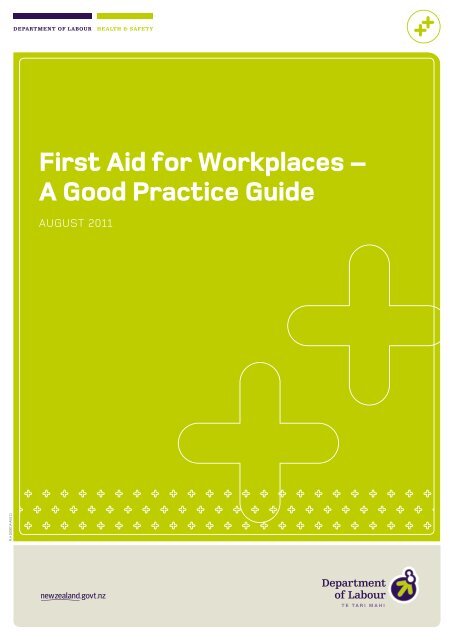

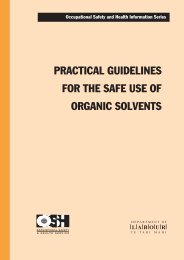
![Task analysis worksheet [161 KB PDF] - Business.govt.nz](https://img.yumpu.com/51400981/1/190x135/task-analysis-worksheet-161-kb-pdf-businessgovtnz.jpg?quality=85)

